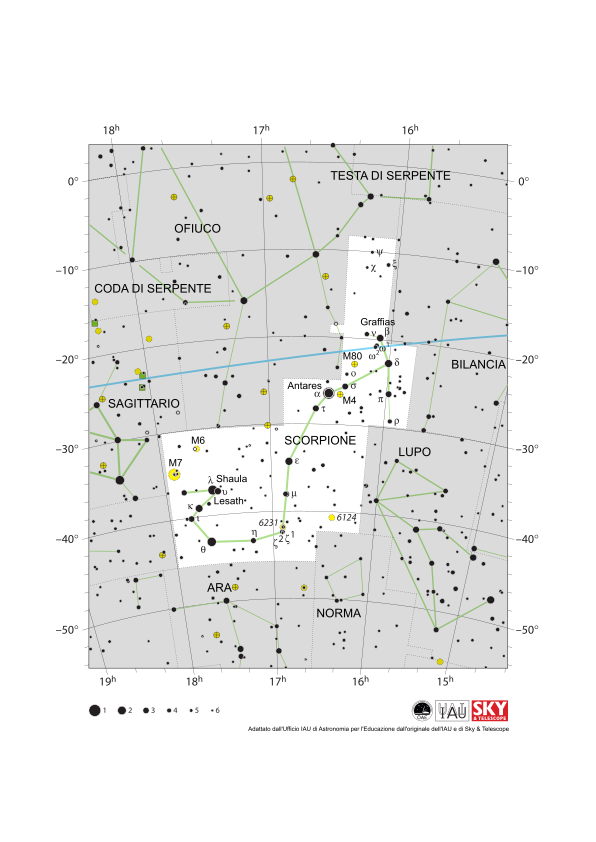This page describes an image Mappa della costellazione dello Scorpione
Scarica il file PDF (PDF file 229.94 kB)
Diagram caption:
La costellazione dello Scorpius (spesso chiamato comunemente Scorpione) con le sue stelle luminose e le costellazioni circostanti. Lo Scorpione è circondato da (in senso orario dall'alto) Ofiuco, Testa di Serpente, Bilancia, Lupo, Norma, Ara, Corona Australe e Sagittario. La stella più luminosa dello Scorpione, Antares, appare nel cuore della costellazione con la famosa coda di Scorpione a sud-est (in basso a sinistra). Lo Scorpione si trova sull'eclittica (qui rappresentata da una linea blu), il percorso che il Sole compie nel cielo nel corso di un anno. Il Sole trascorre solo un breve periodo di tempo a fine novembre in Scorpione. Gli altri pianeti del Sistema solare si trovano spesso in Scorpione.
Scorpione si trova a sud dell'equatore celeste. L'intera costellazione non è visibile dalle regioni più artiche del mondo e alcune parti di Scorpione sono oscurate per gli osservatori delle regioni settentrionali dell'Asia, dell'Europa e del Nord America. Scorpione è maggiormente visibile la sera nell'emisfero settentrionale in estate e nell'emisfero meridionale in inverno.
I cerchi gialli indicano le posizioni degli ammassi aperti M6, M7 e NGC 6231, mentre i cerchi gialli con il segno più sovrapposto indicano gli ammassi globulari M4 e M80.
L'asse y di questo diagramma è in gradi di declinazione con il nord in alto e l'asse x è in ore di ascensione retta con l'est a sinistra. Le dimensioni delle stelle qui segnate si riferiscono alla magnitudine apparente della stella, una misura della sua luminosità apparente. I punti più grandi rappresentano le stelle più luminose. Le lettere greche indicano le stelle più luminose della costellazione. Queste sono classificate in base alla luminosità: la stella più luminosa è etichettata come alfa, la seconda più luminosa come beta e così via, anche se questo ordine non è sempre rispettato esattamente. Il cerchio intorno ad Antares indica che si tratta di una stella variabile. Le linee tratteggiate delimitano i confini delle costellazioni stabiliti dall'IAU e le linee verdi continue indicano una delle forme comuni utilizzate per rappresentare le figure delle costellazioni. Né i confini delle costellazioni né le linee che uniscono le stelle appaiono in cielo. La linea blu segna l'eclittica, il percorso che il Sole sembra compiere attraverso il cielo nel corso di un anno.
Diagram credit: Adattato dall'Ufficio IAU di Astronomia per l'educazione dall'originale di IAU/Sky & Telescope. Link per i Crediti
Stato di traduzione del Diagramma: Non ancora approvato da un revisore
Traduttori del Diagramma: Giuliana Giobbi
Termini di glossario connessi:
Ammasso aperto
, Ammasso globulare
, Ascensione retta (RA)
, Bilancia
, Coordinate celesti
, Costellazione
, Declinazione
, Eclittica
, Magnitudine apparente
, Sagittario
, Scorpione
, Zodiaco
, stella variabile
Categorie:
Astronomia ad occhio nudo
Diagram license: Creative Commons Attribuzione 4.0 Internazionale (CC BY 4.0) Creative Commons Attribuzione 4.0 Internazionale (CC BY 4.0) icone
In Altre Lingue
Inglese: Scorpius Constellation MapSpagnolo: Mapa de la constelación de Escorpio
Cinese tradizionale: 天蠍座星圖
Cinese semplificato: 天蝎座星图
Se noti un errore in questo diagramma, o nella sua didascalia, per favore contattaci.









